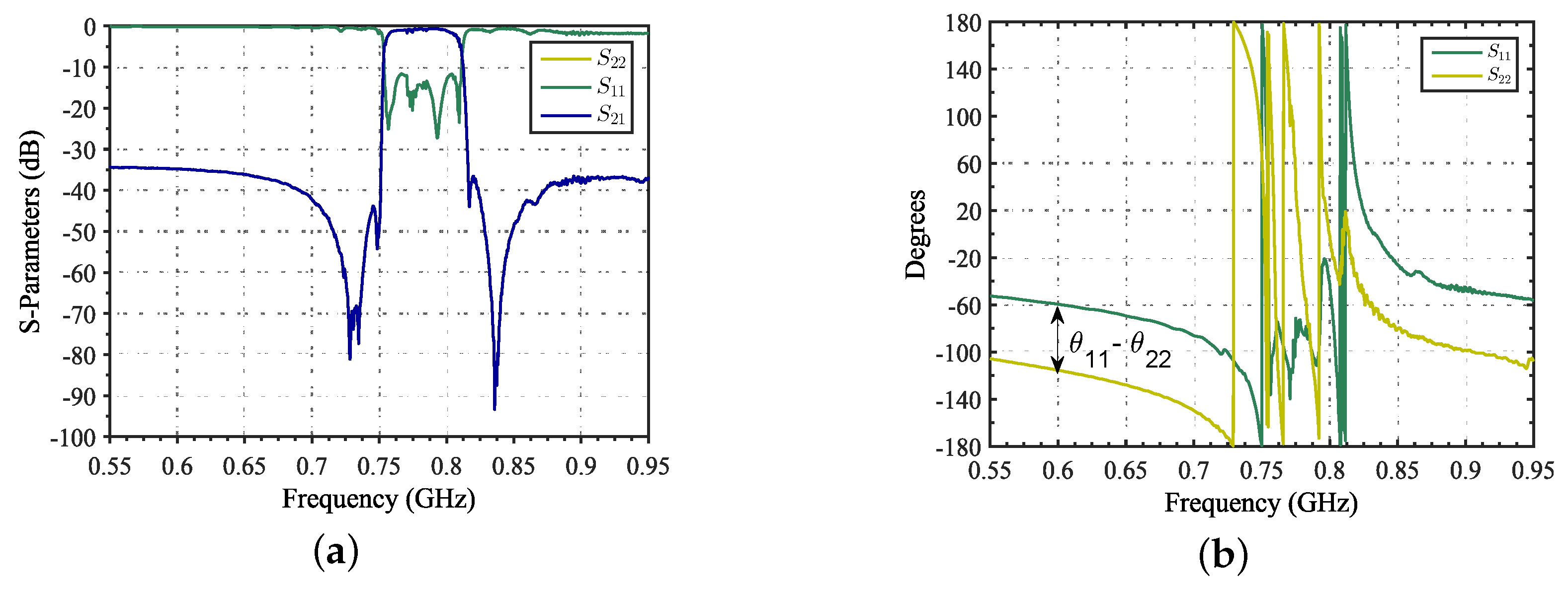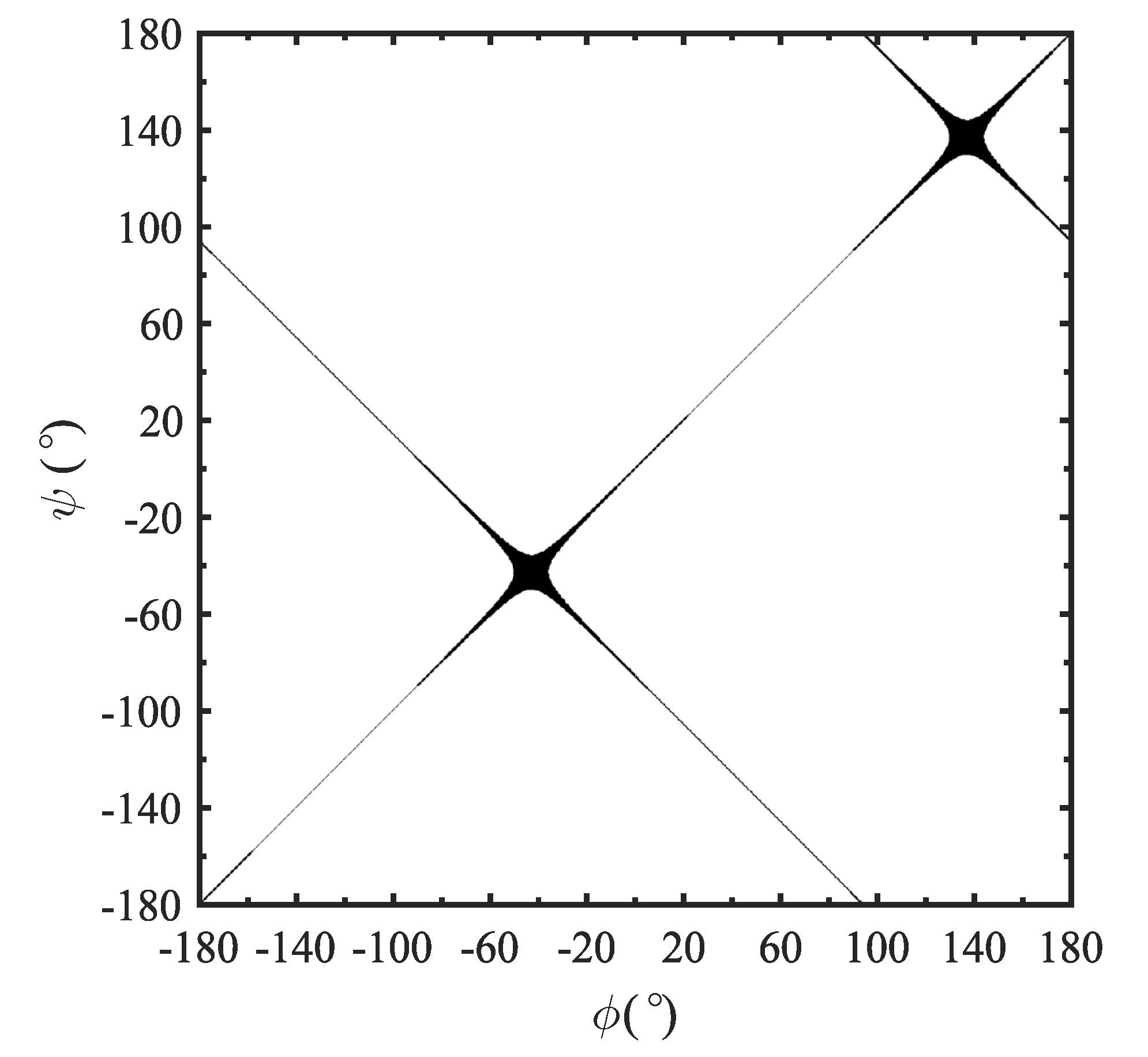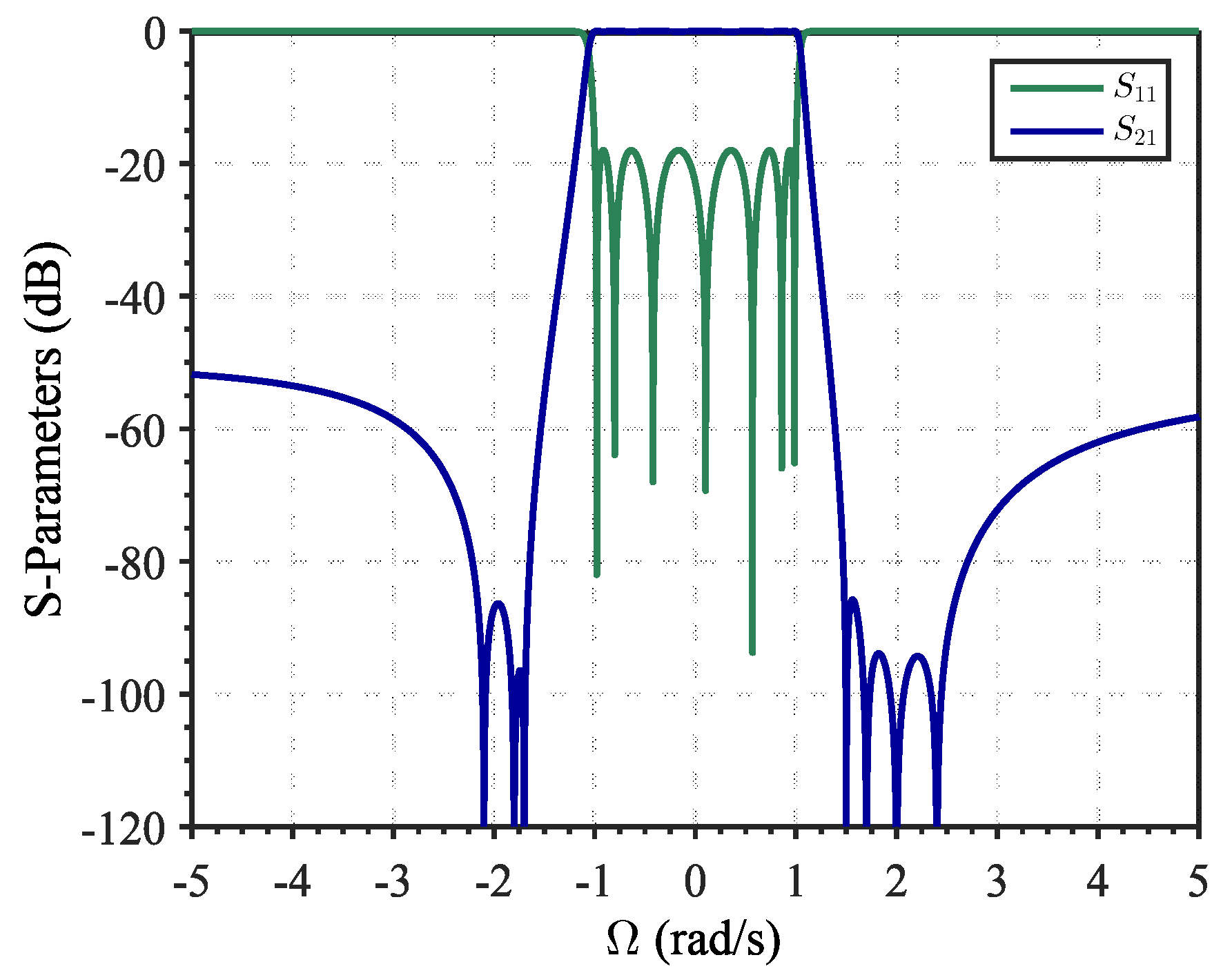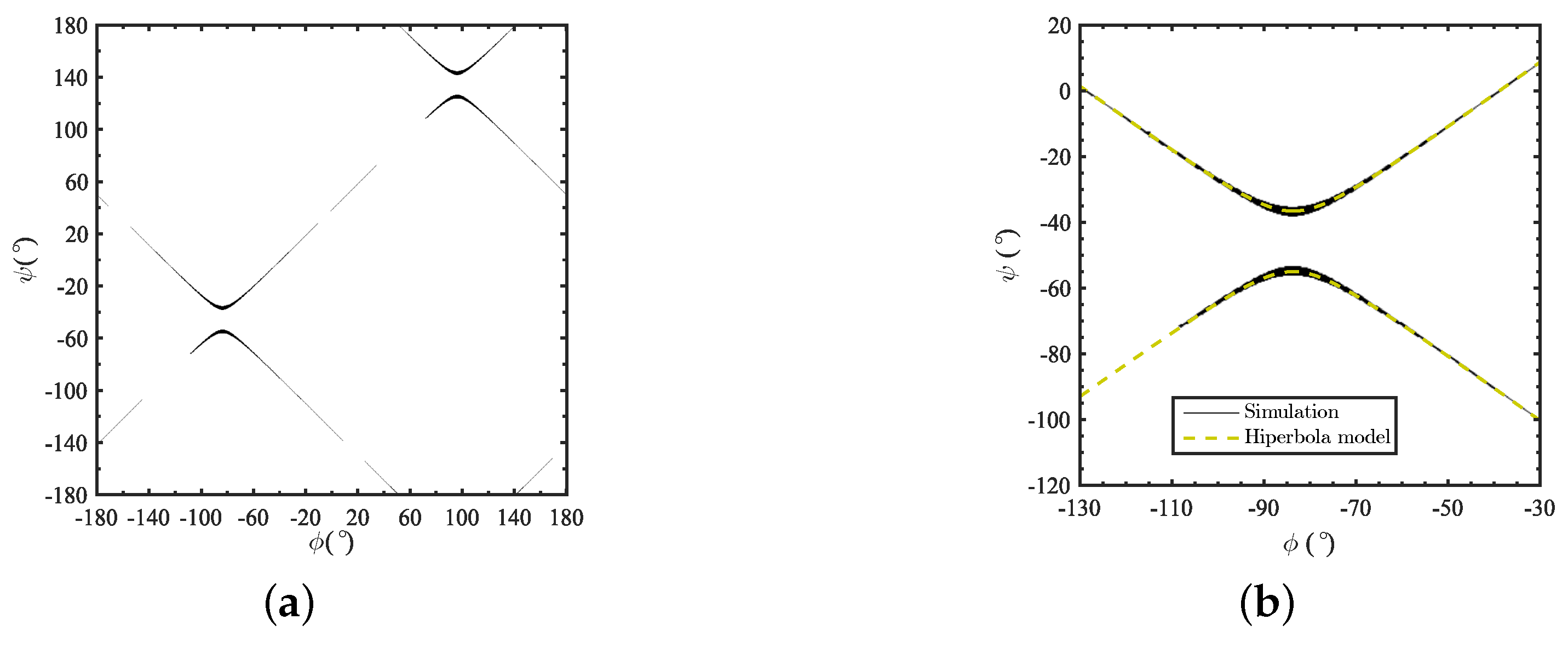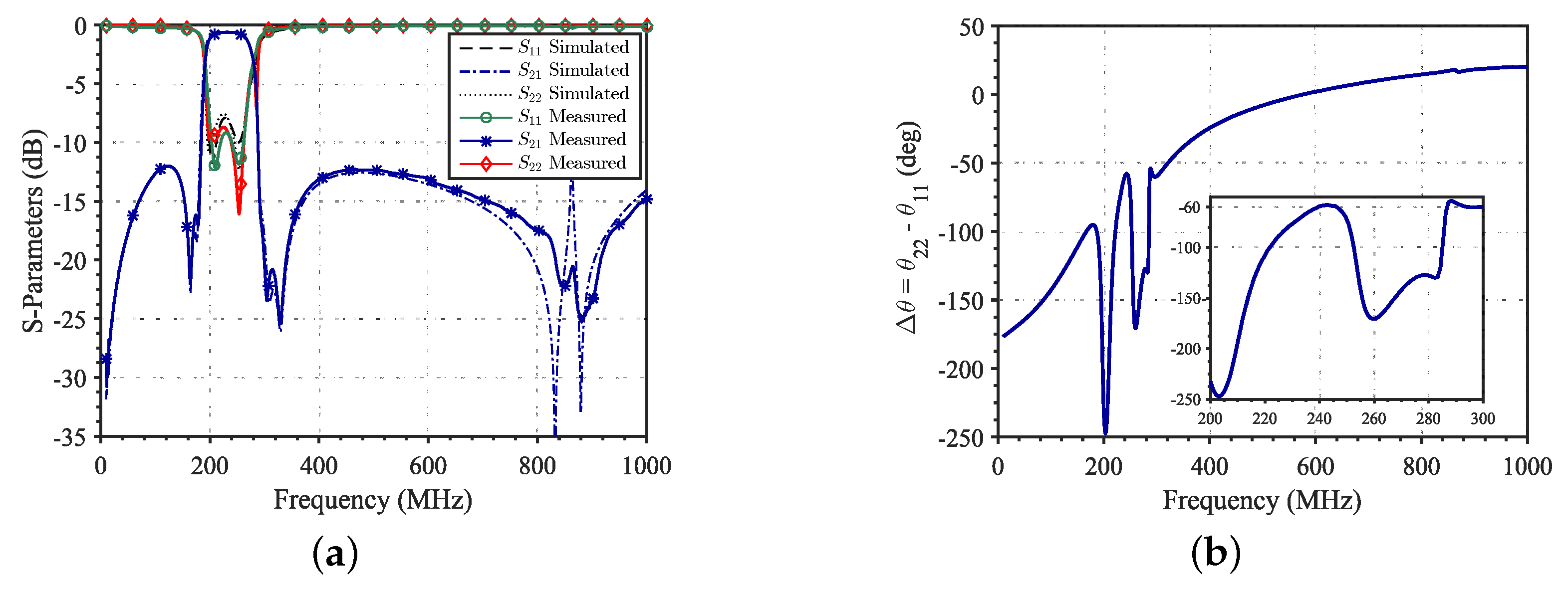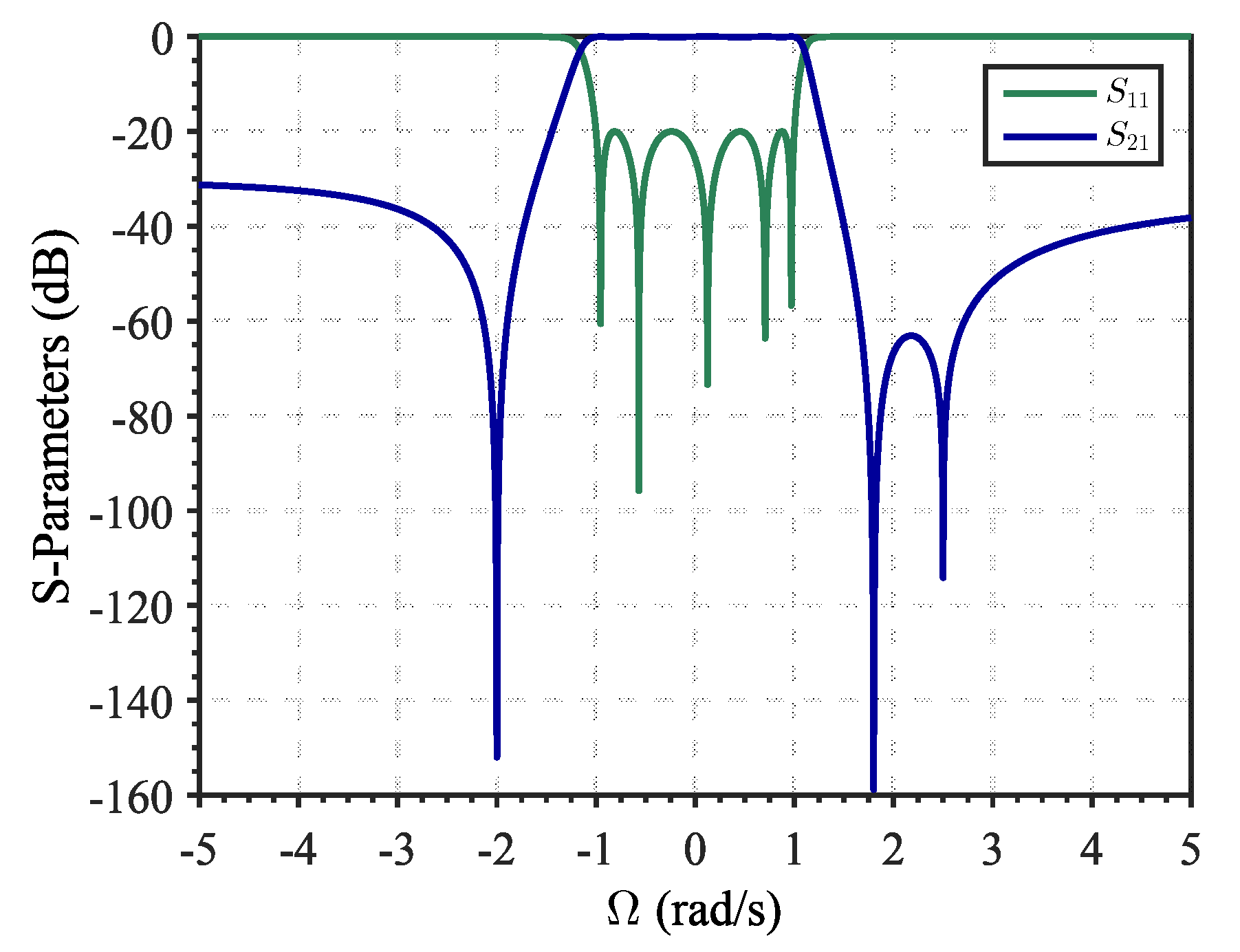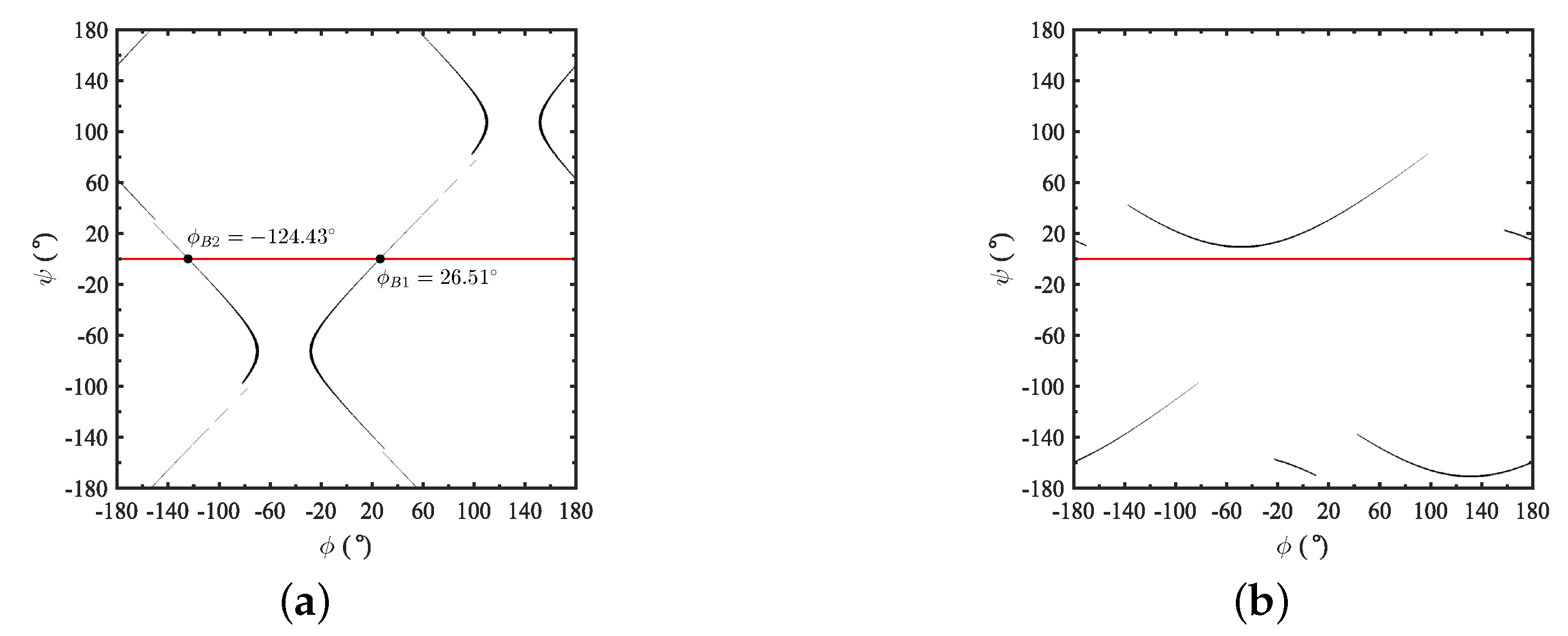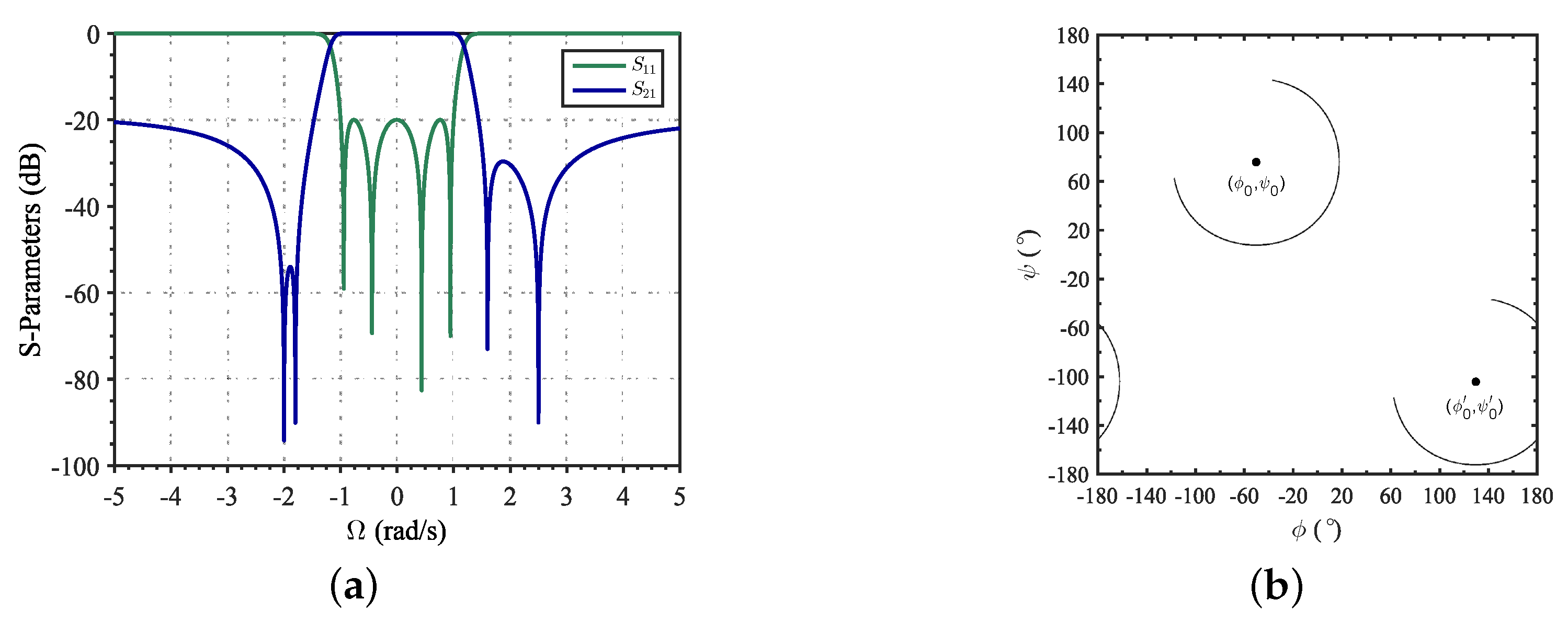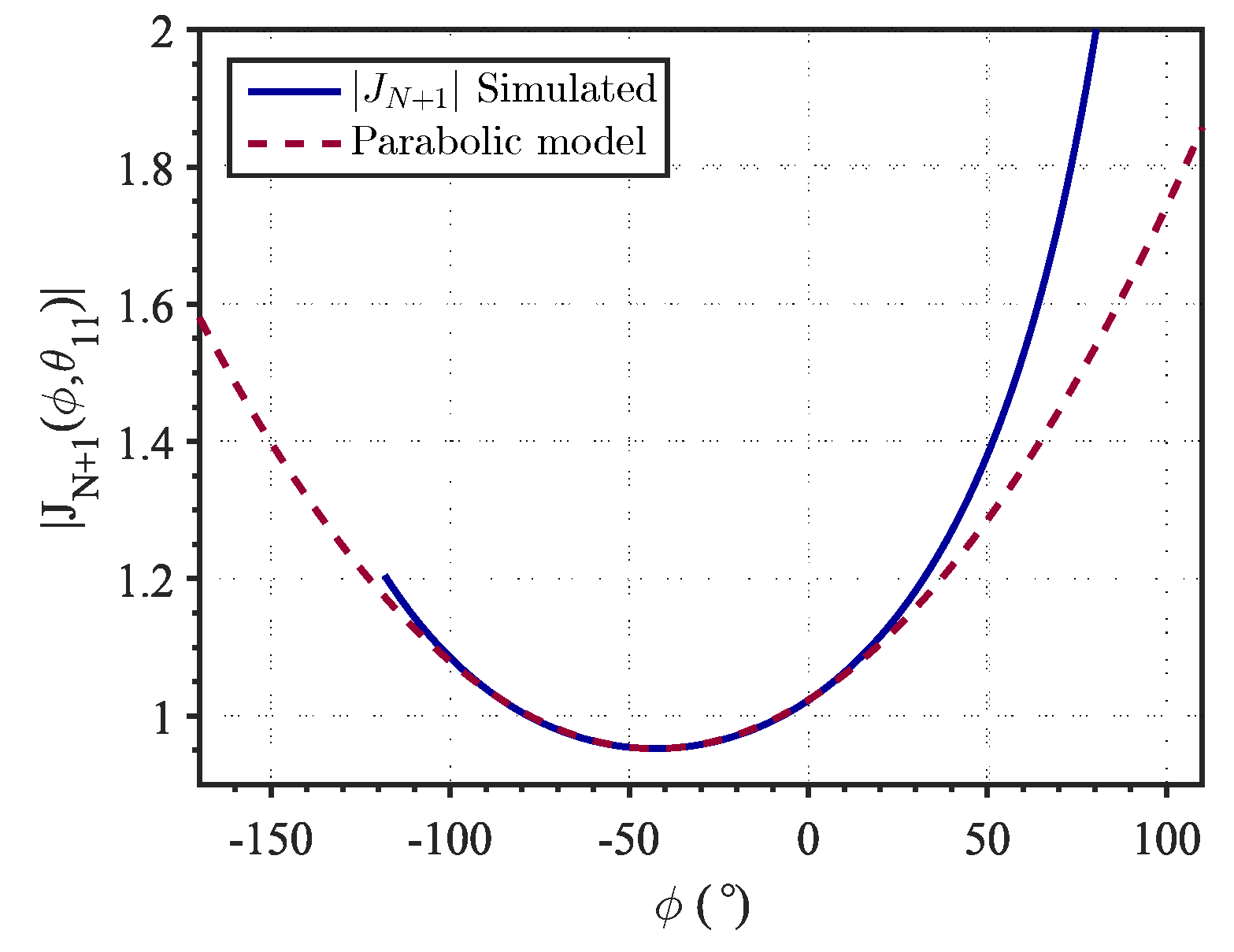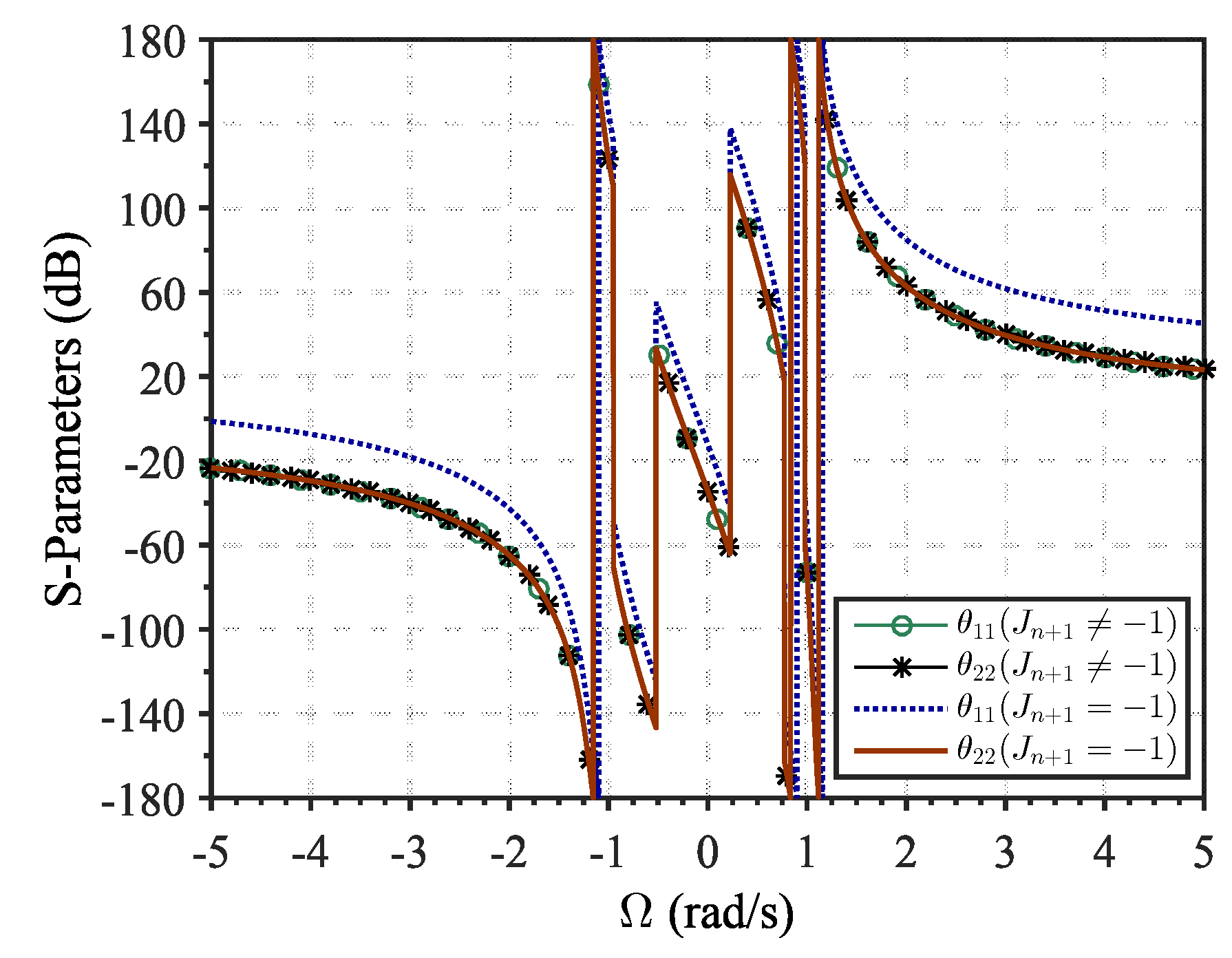1. Introduction
A general fully canonical lowpass prototype network consists of an array of
N shunt-connected capacitors which are synthesized using a circuit elements extraction method. Fully canonical networks can be also successfully described with an inline filter topology allowing the use of the extracted pole synthesis technique [
1,
2,
3,
4]. The equivalent lowpass model configuration can be made of a series of dangling resonators between admittance inverters which are constituted by a combination of resonators nodes (RN) and non-resonator nodes (NRN) coupled to each other by means of immittance inverters
as depicted in
Figure 1.
Usually, the dangling resonators are tuned to the transmission zero (TZ) and the non-resonant node prepares the extraction of the next finite TZ of
th dangling resonator. It is interesting to notice that it is not possible to determine both the main-line and the resonator admittance inverter, respectively,
and
, but only their ratio [
5]. This useful property can lead to multiple solutions suitable for different types of technologies, providing the same transmission and reflection responses.
In the particular case of ladder topologies, the admittance inverters in the main-line
do not exist physically because they are employed in pairs as an instrument to serialize shunt connected resonators [
6]. There is a degree of freedom in setting their values, usually to unity for the sake of simplicity; however, alternation in sign along the source-to-load path is a necessary condition for further lowpass-to-bandpass elements transformation [
7].
Depending on the filter specifications, it may occur that one
cannot be scaled to the common value [
1]. In this situation, the uneven admittance inverter can be moved close to the output port (
in
Figure 1), and apply an admittance redistribution in the last three elements of the network
,
and
with
1. This redistribution process achieves the unitary inverter at the cost of modifying the output phase of the network.
Despite its simplicity and utility, the redistribution solution may not be convenient for every network. For some filter specifications, the admittance redistribution may require changing the impedance of the output port leading to an impedance mismatch. Moreover, in other cases it is not applicable, such as in cross-coupled topologies [
8,
9,
10], where there are ladder networks with a source-to-load coupling embracing the whole main-line inverters. In such scenario, it is not possible to scale the network without changing the value of the coupling, which is not a feasible option.
To overcome this limitation, we propose a method based on the phase correction of the characteristic polynomials of the filtering function
,
and
. The phase modification method attains the same result as the admittance redistribution but modifying the phases of the input and output ports simultaneously in other to equalize all the admittance inverters in a fully canonical lowpass prototype. Unlike the admittance redistribution, a unity terminating output admittance
is always achieved. In addition, the differentiated phase correction of
,
may also be useful for duplexer design where one of the most important features is the isolation between transmitter and receiver filters. In [
6,
7], it is described that the loading effects in both filters can be minimized by modifying the input phase of each filter at the antenna port to a certain specific value. Therefore, by a proper phase correction, both conditions, homogeneous main-line admittance inverters and the phase match for duplexers can be achieved simultaneously.
The methodology to determine the required input/output phases strongly depends on the distribution of TZs as shown in [
11] for odd-order filters. This paper extends the methodology for any class of filter, including also even-order filters, employing a precise mathematical model.
After describing the consequences of the uneven admittance inverter in fully canonical networks in
Section 2, the current solutions and their limitations are discussed. To overcome this problem, the generation of asymmetrical polynomials is proposed in
Section 3. In
Section 4, the space map for suitable additional phase terms to be applied to the characteristics polynomials is explored for each case. The mathematical models and the systematic method to implement the proposed solution is thoroughly described in
Section 5 for odd and even order filters. In
Section 6, an independent experimental validation is reported. Finally, the conclusions are presented.
2. Uneven Admittance Inverters in Inline Fully Canonical Filters with Dangling Resonators
Generically, when the nodes in the main-line of the network are surrounded by admittance inverters, it is possible to scale the impedance at each node to arbitrary values, once the characteristic immittance of the inverters are set to the desired value. Basically, this is equivalent to adjust the transformer ratios of the input and output coupling transformers such that the total energy transferring through the node remains the same [
12].
In ladder topologies, such as the one in
Figure 1, homogeneous values in all main-line admittance inverters are required to succeed in the lowpass-to-bandpass elements transformation [
7]. At each extraction iteration, the ratio of
and
is obtained so
can be set to
. However, the value for the last inverter
is given by the remaining admittance to be extracted, so it cannot be set freely and its value will depend on the filter specifications, specifically, on the TZs distribution. When the TZs are allocated symmetrically with respect to the central resonator along the ladder topology, e.g.,
, all the main-line admittance inverters, including
, can be scaled to
successfully during the extraction procedure. However, if another type of TZs distribution is used, hereafter asymmetrical TZs distribution, such as
, an uneven admittance inverter in the main-line path with a different value than the rest will be required.
For instance, let us consider a filter with TZs at
rad/s and RL
dB. The resulting network scheme is similar to the one depicted in
Figure 1, being the extracted filter elements listed in
Table 1. In this case, the admittance inverters are
. Since the TZs are symmetrically distributed at each side of
, their values are all unitary with alternated sign. However, with an asymmetrical TZs distribution such as
rad/s, in which
and
have been interchanged, the admittance inverters are
, where the
value differs from the others. The rest of the network parameters are shown in
Table 1. Different TZs sorting yields different network parameters; however, as they implement the same filtering function, the S-Parameters for both networks coincide (
Figure 2).
As previously commented, to properly accommodate the network to the ladder topology
must be unitary. A simple solution consists of applying a circuital transformation approach where the real and imaginary parts of the admittance of the last elements of the network are redistributed. In the scenario depicted in
Figure 3, the admittance expression
Y comprises the last NRN
, the load element
and the non-unitary coupling admittance inverter
between them. The input admittance before and after the redistribution can be defined as
Notice that
has been substituted by 1 in the equation. By equaling the real parts
of both expression,
can be derived as
The NRN
can be obtained by equaling the imaginary parts of the admittance as
Usually,
is expected to be 1. However, it can be observed in (
3) that it is only possible if the condition
is satisfied, i.e.,
. Otherwise,
would be imaginary and, therefore, non-realizable. To avoid this situation
can be modified at the cost of an impedance mismatch at the output port since this will not be unitary. For the network obtained with
TZs set,
and
are
The real part of the admittance
is lower than one, therefore,
can be assured. The redistributed element values can be calculated with (
3) are (
4) as
Notice, that the admittance redistribution offers two solutions. The FIR can be either positive or negative depending on the chosen sign, both results are valid but yield different values of and . Therefore, the filter designer can select the reactive element to implement those values as a convenience.
In contrast, if the TZs are
rad/s, the extraction procedure yields the network parameters in
Table 2, and the admittance inverters are
. The real and imaginary parts of the admittance are
and
, respectively. The real part is greater than leading to an impedance mismatch at the output port. To minimize it, the closest value to unity that can be chosen is
. In this case, the FIR at load port will be zero, thus, the new element values are
and
. Although the admittance inverter
is now equalized and the circuital transformation can be done flawlessly, the return loss and in-band response may present a severe deterioration because of the impedance mismatch.
In any case, this method forces the non-equal inverter to be the same as the rest, at the expense of indirectly modifying the output phase of the network, i.e.,
. This involves that a phase shifter is necessary to achieve a fully synthesized filter. The works [
8,
13] show how the filter response is affected when this phase shifter is neglected. Of course, this solution is useful with stand-alone inline configurations, but it requires external reactive elements to compensate for the extra phase, for example when parallel-connected configurations are involved [
8,
9]. In a sense, the non-unitary inverter in the given topology can be understood as a phase reconditioning issue that the filtering function does not provide for a specific TZs distribution among the resonators.
The general polynomial synthesis method for Chebyshev filtering function is generated given the filter order [
14,
15,
16], an arbitrary TZs set and RL. The filtering function and the transfer matrix is built assuming
. If their roots are coincident upon the imaginary axis or they are symmetrically arranged about it, then, the
ith root of
is related to the corresponding root of
, where the polynomial numerator of
is the complex conjugate of
. In terms of reflection coefficient phase, it is known that
.
However, if the prescribed TZs are distributed asymmetrically along the network in a ladder topology, the phase terms
,
are expected to be different in order to comply with the extraction of all homogeneous admittance inverters in the network. In other words, if the TZs of the filter are asymmetrically distributed, asymmetric characteristic polynomials are required. For the sake of clarity, in
Figure 4a there is a measure of a B28Rx seventh-order filter with an asymmetrical TZs distribution. It is observable in
Figure 4b that input and output phases are not equal. This occurrence can be clearly seen in the OoB regions, where the difference between
and
is directly the offset between both traces.
In this section, the phenomenon has been addressed from the admittance redistribution which is equivalent to the modification of the phase of the characteristic polynomials (defined symmetric by nature). However, as it will be further discussed in the next section, this solution can be understood as a particular case belonging to a more general solutions map provided by the use of asymmetric polynomials.
Figure 4.
Magnitude (a) and phase (b) response of a 7th-order B28-Rx filter with a clearly differentiated input and output phases in the out-out-band region.
Figure 4.
Magnitude (a) and phase (b) response of a 7th-order B28-Rx filter with a clearly differentiated input and output phases in the out-out-band region.
3. Asymmetrical Polynomial Definition
The procedure for the definition of the asymmetrical polynomials to deal with asymmetrically distributed TZs filter networks is based on the work in [
17]. The relation between modified scattering parameters and Chebyshev characteristic polynomials is given by:
where the subscript
m refers to modified characteristic polynomials that are defined as follows:
The parameters
and
are complex constants which absolute value is
. With the angles associated with these new variables (
), the phase of
and
can be modified. Both phase terms are bounded together and linked to the phase of
.
The lowpass prototype network synthesis is carried out by means of successive extractions from the
polynomial matrix as described in [
4,
12]. The procedure requires
N recursive steps. For a two-port network having the terminals normalized to unity, the network
matrix is built as follows:
The extracted pole sections are made of a non-resonant node and resonant node pairs (NRN-RN). At each iteration
k, the extraction will be performed at a normalized finite frequency
, being
the iteration number, and
the resonator position. The extracted elements must be removed from the ABCD matrix in (
12) which is updated after every step. Using the classic two-port [S] matrix to
matrix transformation formulas with normalized characteristic impedance, the polynomials
A(s),
B(s),
C(s), and
D(s) in (
12) may be directly expressed in terms of the coefficients of modified characteristic polynomials
,
and
:
Adopting the equations in (
13) the extraction process can be carried out as usual [
12]. If
and
are properly defined, it is expected that the extraction process will yield the last inverter
to a unitary value. However, the definition of the asymmetrical polynomial depends directly on the chosen values for
and
.
4. Phase Determination
With the aim to find out the definition of
and
that yields
, a space map of solutions has been obtained by sweeping both variables, i.e., input and output phase correction, and carrying the extraction of elements in every case. The space map of solutions results in a particular geometric pattern that, as it will be developed through this section, will be different for odd- and even-order networks. For odd-order filters, the suitable phase values are like an equilateral hyperbola while they describe an ellipse in the case of even-order filters. Although both are different, they belong to the same group of geometric shapes, conic sections. They can be defined as non-degenerate curves shape that can be obtained when a plane intersects one or two right circular cones [
18]. They can be differentiated by the eccentricity
e, a constant value that characterizes the shape of a curve. When it is greater than 1, the geometric shape corresponds to a hyperbola, conversely if
, the result is an ellipse. In the following, the method to find all suitable phase values for both cases is described.
4.1. Odd-Order Ladder Filters
To fully characterize a network, for each TZs array , a double phase sweep has been conducted doing complete circuital extractions from the network ABCD matrix, where the effect is located to the last admittance inverter, being and the individual number of sweeps in and variables, respectively.
The
value evolution is obtained as a function of
. Both parameters have been swept in a range from
to
. The values for the pair
,
yielding
describe a map that can be fitted with the parametric equation of a conjugate hyperbola as shown in
Figure 5a,b, respectively.
A hyperbola can be completely defined by four parameters: the hyperbola type (horizontal or vertical), the two slant asymptotes, the origin locus, and the distance from it to the vertex of one branch (
). Whereas it is equilateral in any case, its slant asymptotes have a slope 1 at
. Through observation, it has been discerned that unitary
describes an equilateral hyperbola-like shape which origin location coincides with
,
, given by:
The general equation for equilateral hyperbolas is:
If the LHS of Equation (
15) is negative, the hyperbola aperture is vertical, and horizontal otherwise. The hyperbola type is determined by the
value that results from the network synthesis considering
,
. If
the hyperbola is vertical and horizontal when
.
The value of
can be only known after performing a whole network extraction. In filters which TZs distribution presents internal symmetry and different outer TZs such as
, the hyperbola type could be recognized a priori from the absolute value of the input and output phases
and
obtained using (14). If
, the hyperbola is vertical and horizontal if
. However, this behavior can only be observed in such a case. These phase terms are obtained using the normalized frequency of the first and last TZ of the network. A phase term is greater as the TZ is closer to the center frequency and vice versa. It also should be noted in
Figure 5a, that the both hyperbola-like shapes present periodicity every
degrees in
and
directions regardless its aperture.
Apart from these two orientation types, there is also a third possibility, filters with TZs distribution in such a way that it is achieved
before correcting the polynomial phases. Here, the vertices of both branches are located in the origin of the hyperbola, as shown in
Figure 6. This situation is given, but not exclusively, when the TZs are symmetrically allocated along the network. As expected, the asymptote with positive and negative slope are given by
and
, respectively.
The vertices cannot be inferred directly from the function representation in any of the previous cases. The calculation is carried out by an indirect approach that it will be described in
Section 5.1.
In the following, they are going to be under discussion to illustrate in more detail the three possible results. In the first two cases, the horizontal and vertical hyperbolas are shown; the third case explores filters with TZs distribution which with the initial starting set-up (). Finally, the method used to obtain the vertex location is described.
Hyperbola Types
The analysis of the three cases has been done following the same procedure. First, a network synthesis is done without modifying the polynomials to obtain the used to identify the hyperbola type. Then, the phase sweep is carried out and the results are plotted.
Let us consider first a 5th-order lowpass fully canonical filter with a TZs set
rad/s and
dB. An initial network synthesis yields
. As the admittance inverter is greater than one, the hyperbola is horizontal as the one in
Figure 5a. The center, calculated using (14), is located at
,
.
For the vertical case, a 5th-order lowpass fully canonical filter with a set of TZs
rad/s and
dB is considered. An initial network synthesis yields
, the admittance inverter is lower than 1, meaning that the hyperbola is vertical as shown in
Figure 5b. The center is located in
,
.
As seen in
Figure 5a, the continuity in the function is interrupted at some points. This discontinuity occurs when traces cross the asymptotes of the hyperbolic response. As mention before, the hyperbolas shows a periodicity every
; the traces that appears after the end of the interrupted traces belongs to another hyperbola in other region on the map. A large number of realizations has been carried out obtaining a margin of
for
and
around the origin point, where the continuity is assured.
Considering the absolute value of the uneven admittance inverter as a measure of the asymmetry of the values in a certain TZs distribution, as tends to move away from unity, the further the hyperbola branches are.
The third case is given in filters with symmetric TZs distribution. Let us consider a 5th-order lowpass fully canonical filter with a TZs set
rad/s and
dB. An initial network synthesis yields
. As shown in
Figure 6, the sweep yields two slopes that cross in the center point. That is, the valid pairs
,
are those that lie directly over the asymptotes. It must be also highlighted that in this case, the area in which
is more extensive than previous cases. This leads to less sensitive networks from the point of view of input/output phase shifts. This special case corresponds to a degenerate conic section, described as two intersecting lines [
19], which particular mathematical expression is
Effectively, it can be observed in
Figure 6 that there are identified pairs of angles (
,
) suited to correct the input/output phase of the network. Moreover, as the solution is not unique, the designer has the chance to select that pair of phase values which leads to obtaining
=1, but at the same time considering other phase requirements as it could be the case of avoiding loading effects in the design of duplexers or multiplexers [
6].
Figure 6.
Phase sweep plot when the distance to the vertex is zero. The black trace represents those combinations of , that yields . For illustration purpose all values that fit in have been plotted.
Figure 6.
Phase sweep plot when the distance to the vertex is zero. The black trace represents those combinations of , that yields . For illustration purpose all values that fit in have been plotted.
When the network is synthesized applying the phase correction using (
,
) corresponding to one of the vertices, one of the reactive input/output elements will be zero because one of the phase terms cancels the input or output phase. If the hyperbola is vertically orientated
, which is
, the new input phase will be zero and no reactive element at the source port
is necessary [
1]. Conversely, if the hyperbola is found to be horizontal, the reactive element at the output port will be zero. Besides, if different valid (
) pairs are used, none of the input/output reactive elements will be null.
4.2. Relationship between the Phase Map and the Admittance Redistribution Method
As was described in
Section 2, the described method to equalize the inverter values in the main-line by an admittance redistribution modifies
without altering
. Hence, this is equivalent to pre-modify the characteristic polynomials before the circuital extraction with
and certain value for
.
The filter used to exemplify the admittance redistribution with
TZs showed two values for
, positive or negative depending on the sign of the square root. These solutions lead to two different circuit elements or, equivalently, two additive output phase terms
and
. Before the redistribution,
and the phase term is
. Once the redistribution is done,
, that yields
. Therefore, the additive phases can be obtained as
In the original synthesized filter, the last admittance inverter is
, lower than 1. Thus, a double phase sweep of the characteristic polynomials describes the vertical hyperbola shown in
Figure 7a. It can be noted that there are two points cutting the hyperbola (solutions for
=1) at
, and these two values correspond with
and
. This result reveals that the circuital transformation done by the admittance redistribution is actually a particular case within the hyperbola.
On the other hand, a particular TZs distribution may lead to a situation in which the admittance distribution is not possible unless impedance mismatch is allowed as it was the case with TZs
. The double phase sweep of this filter yields the phase map in
Figure 7b. It can be observed that no point is cutting the hyperbola at
= 0. In other words, there is no additive output phase
that can correct the last admittance inverter if the input phase term
is zero. This brings to light the cause of the admittance redistribution method applicability limitation, and reinforce the necessity of the asymmetrical polynomial definition in such cases.
From both phase maps in
Figure 7 it can be concluded that in all networks with
(vertical hyperbola), the redistribution is always possible because there exist a cutting point at
in both branches. However, for those networks with
(horizontal hyperbola), it may occur that no branches crosses the line at
. In this case, to equalize the uneven inverter is necessary to change, at least, the input phase with a non-zero
value.
4.3. Even-Order Ladder Filters
A symmetric distribution of the TZ in odd-order networks can be achieved by having the same resonant frequencies at both halves of the network, considering the central resonator as an axis of symmetry. Hence, even-order filters do not posses symmetry under these terms and the unitary admittance inverters can only be achieved, without any phase correction, by a careful selection of TZs and RL values. For example, with the network with TZs
rad/s and
dB, which network parameters are listed in
Table 3, the admittance inverters are
.
In any event, the unique geometric shape that defines the input and output phases (
) providing an unitary admittance inverter for even-order filters is an ellipse. To illustrate the phenomenon, let us consider a 4th-order fully canonical filter with a TZs
and RL
dB, with the network parameters in
Table 4 and S-parameters in
Figure 8a. The synthesis yields
. The result of the sweep reveals the ellipses in
Figure 8b.
In this case, the location of the origin at and can be also determined using (14), and periodicity in the ellipse every in both axis ( and ) is observed again. The origin in this case is located at (, ). However, unlike the odd-order filters, the even-order do not show any variation in shape.
Besides, it can be noted that the black trace in
Figure 8b never cuts
. That is, even-order filters may be susceptible to not have any output additive phase term
that can provide a unitary admittance inverter
without modifying the input phase. In consequence, it may exist network configurations in which the admittance redistribution method is not applicable either.
The ellipse can be completely characterized by three parameters: the center location, the major radius and minor radius, where the general equation is
To keep coherence with the rest of the text, the radii will be referred as and in function of the axis in which they are defined instead of their length from the center.
6. Experimental Validation
To validate the proposed methodology, a
N = 5 order filter has been synthesized using the procedure in [
6], symmetric polynomial definition,
dB, and allocation of the transmission zeros in the lowpass domain
rad/s. The extracted elements of the lowpass prototype are shown in
Table 8. The elements with subscript
b correspond to those obtained directly from the synthesis procedure. In this case, the last inverter
, from the phase point of view,
Figure 13 shows that
as expected since symmetric polynomials have been used.
The dangling resonator can only be serialized if the side inverters are equal with the opposite sign. As was previously discussed, a possible solution consists of applying a redistribution of the values of the last three elements of the network, the last two FIRs and the admittance inverter coupling them, to turn the last admittance inverter unitary. This is seen in the elements with subscript
a in
Table 8, where the FIR
for resonator 5 and the load elements have been modified. In this case, as expected, the last inverter
so the serialization is possible; however, a phase shift of
in the main-line is required for the exact and complete synthesis. The lack of such phase shifter entails that
leading to a phase difference
−
= −22.1
.
For the sake of clarity, in
Figure 14, the nodal representation of the directly synthesized network is compared with the network once the element transformation is carried out to achieve the
. Therefore, the presence of the phase shifter in the main-line path is mandatory to have a perfect equivalence between both networks.
To have an exact and complete synthesis of the filter, the proposed phase correction method has been applied with
and
. In this case, the resulting last inverter
= −1 as expected. The transformation to the bandpass domain results in the very well-known Butterworth-Van Dyke equivalent circuit [
6] as shown in
Figure 15a, where the value for the elements are summarized in
Table 9. The frequency transformation has been done considering
MHz and BW
MHz.
As a proof of concept and for rapid prototyping, the filter was made in FR4 with ENIG surface finish. The resonators were implemented with Wirewound High-Q Chip Inductors and Multi-layer High-Q Capacitors from Johanson Technology. The estimated
Q factor for inductors and capacitors are, respectively,
and
. The measured transmission response, as well as the input/output reflection coefficient, are shown in
Figure 16a. The insertion losses are
dB as expected from the EM simulation, taking into account the finite
Q factor of the lumped components. The tolerances in the used commercial values of the components are also responsible for the detuning of the upper TZ closest to the bandpass, which at the same time results in a certain degradation of the RL and achieved BW.
On the other hand,
Figure 16b shows the measured difference between the phase of the input and output reflection coefficient
. The response is in a very good agreement with the specifications of the filter where the theoretical difference is
. It has to be highlighted that in this case, unlike the method based on the redistribution of the network, no phase shifters are required for the serialization of resonators.
Figure 16.
(a) Measured and simulated filter transmission response, and input/output reflection coefficient. (b) Difference between input and output measured reflection coefficient phase . The simulation was carried out with ANSYS® Electronics Desktop 2021 R1. The manufactured filter was characterized with the network analyzer N5242B PNA-X.
Figure 16.
(a) Measured and simulated filter transmission response, and input/output reflection coefficient. (b) Difference between input and output measured reflection coefficient phase . The simulation was carried out with ANSYS® Electronics Desktop 2021 R1. The manufactured filter was characterized with the network analyzer N5242B PNA-X.
